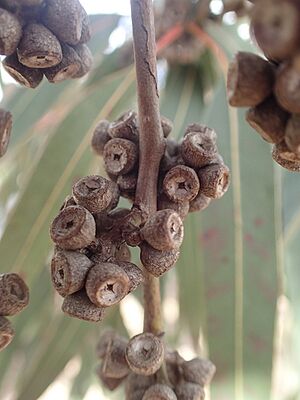Hillgrove gum facts for kids
Quick facts for kids Hillgrove gum |
|
|---|---|
 |
|
| Eucalyptus michaeliana in the Oxley Wild Rivers National Park | |
| Conservation status | |
|
Rare (NCA)
|
|
| Scientific classification | |
| Genus: |
Eucalyptus
|
| Species: |
michaeliana
|
The Hillgrove gum (also called brittle gum) is a special type of tree found only in eastern Australia. Its scientific name is Eucalyptus michaeliana. This tree is usually small to medium-sized. It has smooth, patchy grey bark. Its leaves are long and narrow, and its flowers are white. After flowering, it grows cup-shaped or barrel-shaped fruits.
Contents
About the Hillgrove Gum
The Hillgrove gum is a tree that can grow up to 30 meters (about 100 feet) tall. It has a special woody swelling at its base called a lignotuber. This helps the tree regrow if it gets damaged, for example, by a bushfire.
Its bark is smooth and has patches of grey, white, or cream colors. This bark peels off in flakes. Young trees and new shoots from the base (called coppice regrowth) have long, narrow leaves. These leaves are dull green on both sides and are about 5 to 15 centimeters (2 to 6 inches) long.
Adult leaves are also long and narrow, sometimes slightly curved. They are about 9 to 18 centimeters (3.5 to 7 inches) long. These leaves grow on a stalk called a petiole, which is about 1.5 to 3 centimeters (0.6 to 1.2 inches) long.
The tree's flower buds grow in groups. Each group has three or seven buds. These groups are found on a small stalk called a peduncle, which is about 3 to 5 millimeters long. Each individual bud sits on an even smaller stalk called a pedicel.
When the buds are ready to open, they are oblong-shaped, about 5 to 6 millimeters long. They have a cap-like cover called an operculum. The Hillgrove gum flowers in March, and its flowers are white. After the flowers, the tree produces woody fruits. These fruits are shaped like a cup or a barrel and are about 3 to 5 millimeters long.
How the Hillgrove Gum Got Its Name
The scientific name Eucalyptus michaeliana was first officially described in 1938. A scientist named William Blakely gave it this name. He studied samples of the tree that were collected near a place called Hillgrove in 1907.
The second part of the name, michaeliana, honors a clergyman named Norman Michael (1884–1951). He was a plant collector who found this species in Queensland in 1937.
Where the Hillgrove Gum Lives
The Hillgrove gum grows in woodlands where the soil is sandy. It has a "disjunct distribution," which means it's found in separate areas, not all in one continuous patch. You can find it in parts of New South Wales, between St Albans and Wollomombi. It also grows in the south-east part of Queensland.
See also
 In Spanish: Eucalyptus michaeliana para niños
In Spanish: Eucalyptus michaeliana para niños




